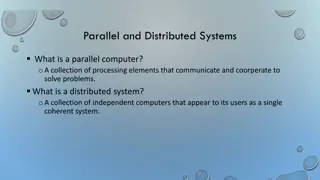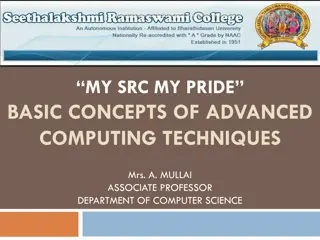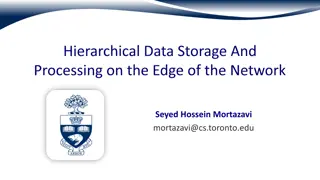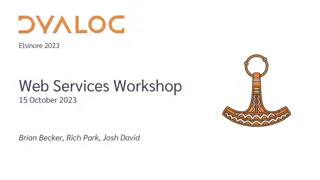Web Services: A New Computing Paradigm
Web services revolutionize business operations over the Internet by enabling seamless communication and data sharing through standardized protocols like XML. They offer a specific set of operations accessible via HTTP, facilitating system-to-system interactions and interoperability. This chapter explores the definition, benefits, examples, characteristics, and architecture of web services, highlighting their role in distributed computing environments.
Uploaded on Oct 06, 2024 | 0 Views
Download Presentation

Please find below an Image/Link to download the presentation.
The content on the website is provided AS IS for your information and personal use only. It may not be sold, licensed, or shared on other websites without obtaining consent from the author.If you encounter any issues during the download, it is possible that the publisher has removed the file from their server.
You are allowed to download the files provided on this website for personal or commercial use, subject to the condition that they are used lawfully. All files are the property of their respective owners.
The content on the website is provided AS IS for your information and personal use only. It may not be sold, licensed, or shared on other websites without obtaining consent from the author.
E N D
Presentation Transcript
Lebanese University Faculty of Economic Sciences and Business Administration- First Branch Lecture notes in Web services Chapter 2 Web services :a New Computing Paradigm Prepared by Dr. Lina Nimri for M2 Informatics class Based on: Web Services - A Technical Introduction, Deitel
Plan What are Web Services? Web services: Web tool or Distributed Computing? Benefits of Web services over the other Distributed Computing Technologies (DCT) Benefits of Web services over software hosted by ASPs Web services examples Key Web Services Technologies: SOAP; WSDL;UDDI Development of Web services standards Web services limitations
What are Web Services? Web services change the nature of business conducted over the Internet To facilitate business tasks applications must communicate and share data. WWW and XML have increased the possibility for interoperable system-to-system communications. Web services are software programs that use XML to exchange information via Internet protocols. Web services supply a specific set of operations that other application can access and use via HTTP. Examples: a Web portal might obtain top news from Press WS a financial application might employ a Web service that checks a stock quote Web services characteristics: Web services are programmable: when an application passes data or instructions to it the Web services processes that information and returns results Web services are based on XML which provides interoperability Web services are self-describing (accompanied by information written in WSDL) explaining them Web services are discoverable through registries based on UDDI
Web Services: Web Tool or Distributed Computing? UA Web application is built on a multi-tier architecture: The information tier (bottom tier): that stores information or DB The business tier (middle tier): an intermediary between data and clients that controls and processes business logic The client tier (presentation or top layer): that provides the applications UI. It has been difficult to find an effective way to enable Web-based applications to communicate with one another. By contrast Web services provide a standard method for enabling communications between applications middle tiers over a network regardless of the platforms.
Web Services: Web Tool or Distributed Computing? A Web service is a new distributed computing environment: by enabling applications to communicate effectively in a distributed environment, Web services help developers change the way in which they design software, a major step towards distributed computing. Unlike Web sites, Web services are designed to be accessed and employed by other applications.
Benefits of Web Services over Other Distributed Computing Technologies (DCT) Previous distributed computing technologies are: Very complex Prone to errors Do not work well across firewalls Not scalable enough to support the Internet Are specific to the vendor or platform Do not provide true interoperability Web services benefits over distributed computing technologies: Companies do not have to invest new infrastructure (can be adopted quickly) More interoperable as they employ XML to communicate Software vendors have agreed to use the same standards (SOAP, WSDL, UDDI)
Benefits of Web Services over Other Distributed Computing Technologies (DCT) Thus Web services: Can facilitate business processes Have the potential to change the entire process of designing, developing and deploying a software (new paradigm for distributed computing) Could improve collaborative software development as we can combine code written in any language on any platform Could result in the emergence of more modular applications, so that customers can create their own applications by mixing and matching pieces of the wanted functionality, which provides reliability and reusability.
Benefits of Web Services over Software Hosted by ASPs Since 1998 ASPs have provided customized business software applications for a fee over the Web. But the expense of maintaining and updating hosted software has resulted in high costs. Hosted applications typically provide a user interface while Web services provide programming interface Web services are developed and maintained by the same entity, while most ASPs host software that is created and owned by others. ASPs offer large applications with limited customizations, while Web services can be smaller components that perform specific functions, which provides flexibility to assemble own applications from multiple vendors. Web services simplify the process of supplying data to business applications.
Web Services Examples Credit card validation News headlines Currency converters Sports scores Daily horoscopes Stock quotes A service that returns the current bid price of eBay auction Zipcode resolver by eraserver.net Package shipment tracking Current temperature Traffic on highways Interactive online games
Key Web Services Technologies: SOAP; WSDL;UDDI 1) The service provider publishes service descriptions into UDDI registry 2) The client requests the registry to locate service 3) Registry refers client to WSDL document, client accesses WSDL document that provides data to interact with Web services 4) Client sends SOAP-message request to the service provider 5) Web service returns SOAP-message response to the client
Development of Web Services Standards W3C is the largest standards body involved in the advancements of Web services technologies (founded by Tim Berners Lee in 1994). W3C Working Group: a group that presents recommendations. A specification passes through many phases before it becomes a standard: working draft, candidate recommendation, proposed recommendation, recommendation. OASIS: Organization for the Advancement of Structured Information Standards.
Web Services Limitations Developers are worried that Web services created with current software tools will not be compatible with future standards Web services technologies might be licensed by major software vendors (mainly Microsoft and IBM property rights) which might impose a fee. Parsing XML needs time, which means that applications using SOAP to transmit data will not be as quickly as comparable applications No standards or monitoring performance (QoS) No standard billing schemes for Web services mechanisms for Web services
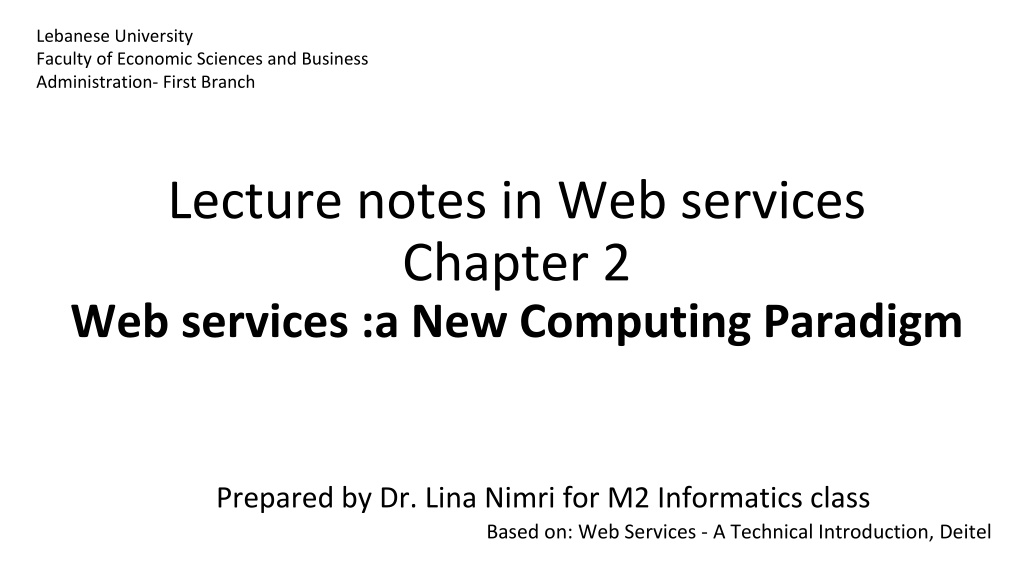

![[PDF⚡READ❤ONLINE] Black Hole Astrophysics: The Engine Paradigm (Springer Praxis](/thumb/21503/pdf-read-online-black-hole-astrophysics-the-engine-paradigm-springer-praxis.jpg)

